| < Prev | Next > |
|---|
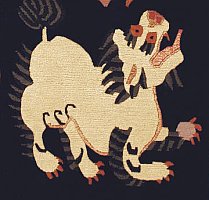 As is the case with all genres of Asian art and handicrafts, the design of Tibetan carpets is seldom just a decorative work of art. Carpets can also be the bearers of encrypted messages.
As is the case with all genres of Asian art and handicrafts, the design of Tibetan carpets is seldom just a decorative work of art. Carpets can also be the bearers of encrypted messages.
Buddhist Symbols and Tibetan Rugs
Buddhist symbols, depending on their use and combination with other symbols, could mean completely different things. The language of symbols is clearly recognizable in the art of carpet knotting. The motifs of Tibetan carpets are for this reason more or less readable.
Pictures as a Language
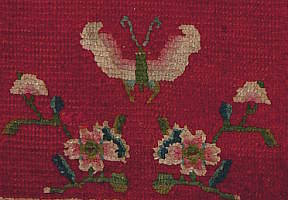 In Western art the meaning of supporting attributes simply add to scenic illustrations. In Asian art, however, the symbols themselves are the subjects of a visual composition. Rarer complex illustrations date back to tales and sayings, or to the traditional customs of the imperial court in China. In another form of symbolic encryption, two similar sounding words are used. For those who are unfamiliar with the intricacies of the language, the meaning of the word in context is detached or "encrypted."
In Western art the meaning of supporting attributes simply add to scenic illustrations. In Asian art, however, the symbols themselves are the subjects of a visual composition. Rarer complex illustrations date back to tales and sayings, or to the traditional customs of the imperial court in China. In another form of symbolic encryption, two similar sounding words are used. For those who are unfamiliar with the intricacies of the language, the meaning of the word in context is detached or "encrypted."
Tibetan Carpets and Religion
Tied to Tibetan tradition, the language of symbols of Tibetan carpets dates back to Buddhist tradition. The carpets, however, are not cultic artifacts but rather are used in everyday life. Their illustrations show neither deities nor religious scenes. They are, in fact, bearers of specific symbols that bring luck, well-being or a long life to the owner.
Common Motifs
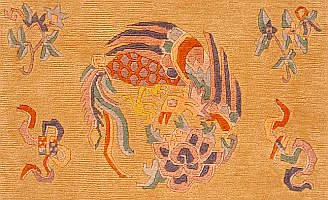 The Buddhist iconography offers many symbols that in Tibet date back to the Chinese tradition. Not all these symbols are found or used in the illustrations of Tibetan carpets. Next to the dragon and the phoenix, which belong to legendary animals of the Chinese Tang Dynasty (along with the tortoise and Qi Lin, a.k.a. unicorn), snow lions, cranes, tortoises, etc. as well as floral symbols can be found in scenes in Tibetan carpets. Selected examples:
The Buddhist iconography offers many symbols that in Tibet date back to the Chinese tradition. Not all these symbols are found or used in the illustrations of Tibetan carpets. Next to the dragon and the phoenix, which belong to legendary animals of the Chinese Tang Dynasty (along with the tortoise and Qi Lin, a.k.a. unicorn), snow lions, cranes, tortoises, etc. as well as floral symbols can be found in scenes in Tibetan carpets. Selected examples:
Dragon
Dragons are symbols for power, strength and divine protection. They also stand for wisdom, fortune and advancement. In the Chinese iconography they represent the highest divine power on Earth and were, for that reason, reserved for the emperor. The dragon stands for the Yin, symbolizing the East and the rain. Additionally it is a male element and can also denote virility.
Phoenix
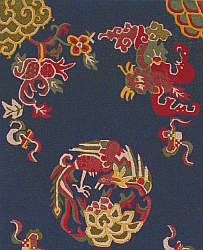 The mythical bird phoenix combines the five qualities of a respectable life: virtuousness, a sense of duty, blamelessness, humanity and dependability. In its symbolic grace and elegance, the phoenix was also a symbol reserved for an empress in China.
The mythical bird phoenix combines the five qualities of a respectable life: virtuousness, a sense of duty, blamelessness, humanity and dependability. In its symbolic grace and elegance, the phoenix was also a symbol reserved for an empress in China.
Dragon and Phoenix
Especially in the Chinese iconography, the combination of the dragon and phoenix developed a new meaning. Together, they represent the imperial pair (emperor and empress), the harmonic unity of masculinity and femininity, as well as that of Yin and Yang.
Butterfly
Butterflies are mostly found in connection with floral displays and symbolize infatuation.
Orchids
The orchid stands for refinement and humility, but above all for the feminine beauty that is represented by the sweet scent the orchid gives off.
Chrysanthemum
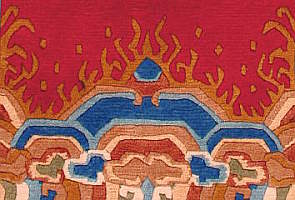 The Chinese word for chrysanthemum sounds similar to the concept of "resistance" or "to take a stand" as well as "a long time" or a "long life." The chrysanthemum therefore also symbolically represents these things.
The Chinese word for chrysanthemum sounds similar to the concept of "resistance" or "to take a stand" as well as "a long time" or a "long life." The chrysanthemum therefore also symbolically represents these things.
Lotus
From the pronunciation of the word, the lotus flower is associated with wealth and honor. The delicate pink blossom, however, confers beauty, charm and purity.
Phenomena
Occasionally scenic descriptions or elements are presented in Tibetan carpets. These also have their own symbolic meaning. The clouds stand for fortune, peace, and for the unity of Yin and Yang. Fire, on the other hand, is a symbol for the day and manliness.
Floral Forms
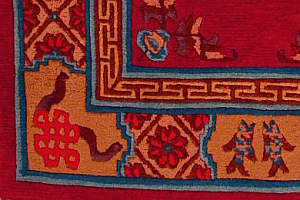 Also the non-pictorial adornments stand for the connection with the Buddhist tradition. A commonly occurring element is the Buddhist knots or the eternal knots. It symbolizes the eternal life, but also the lasting fortune. The medallions are connected to the Buddhist symbol of the wheel, which represents durability, stability, as well as the cycle of rebirth.
Also the non-pictorial adornments stand for the connection with the Buddhist tradition. A commonly occurring element is the Buddhist knots or the eternal knots. It symbolizes the eternal life, but also the lasting fortune. The medallions are connected to the Buddhist symbol of the wheel, which represents durability, stability, as well as the cycle of rebirth.
Dieter Wanczura







